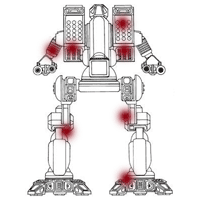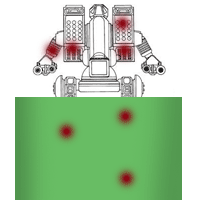
|
Playing By The Rules... Mostly.
|
This is the
page where I basically belly-ache about something I have
only limited control over, FASA's dumb-ass rules for Battletech,
circa 1987-1997. Generally speaking, I was always a firm
adherent to FASA's rules no matter what. House Rules generally
made less sense and always resulted in massive confusion,
and the occasional fist-fight, at gaming conventions.
Any variations of the rules in my group were generally
logical extensions of what FASA already provided, not
fabrications from whole cloth. More on that in a minute.
|
Dumbness
Levels
The primary problem I had with FASA's rules was that they
considered the Battletech environment to be no more than
a cartoon reflection of the real world. It was basically
limited to only two dimensions, height and width, and
gave only the shortest of shrifts to the Z axis. For example:
Two mechs are standing in adjacent hexes, one is at Level
Zero and the other is at Level Three. As anyone who understands
the game would know neither unit requires a to-hit modification
despite the difference in their respective elevations.
This was never a problem using FASA maps as they never
offered a level difference greater than five.
Now consider again those same two mechs, except now one
is at Level One and the other is at Level Three Billion
(or Level Infinity Plus One, for that matter). By FASA
rules they could shoot at each other all day with Small
Lasers. This bonehead rule made playing on custom maps
featuring entertainingly different level changes a rather
surreal event.
The logical thing to have done would have been to taken
the level difference between units, divide it by two,
round it down, and then add the result to the distance.
I never implemented such a sensible scheme because it
was clearly a new and complicated set of rules and my
group just didn't do that.
Partial Cover
This one is REALLY stupid, as you can see by this example:
 |
 |
On the left is a 'mech receiving
damage from seven weapons. On the right is the same mech
if it was standing behind a Level-One bit of terrain.
Obviously the weapons that struck the legs would hit
the intervening terrain. By this logic you should
be able to use the +3 upper-body modifier any time you
wanted.
But wait! There's more stupidty! How much of a Flea is
going to be visible above a 1-level rise versus
an Atlas? Answer: None. This rule is clearly
designed to
make
the
game
shorter,
not smarter.
That's bad game design, folks.
The Partial Cover rule should be altered to reflect my example. I.E. all hits
to the legs should be dismissed entirely if hidden by terrain. If a Mech is in
water,
apply
full
damage as a little water isn't going to stop 30th century targeting and weaponry.
(Flamers, Infernos excluded. In which case use my modified
Partial Cover rule, with leg hit being a clear miss.)
As for smaller 'Mechs, you could house-rule the hell
out of partial cover to make the game more interesting.
For example, something like a Jenner would only expose
their
head
and shoulders from behind a piece of level-one terrain,
meaning they could stand and pop off SRMs and laser fire
from
relative safety. A new movement like
Kneel would allow larger 'mechs to similarly crouch and
snipe.
Snake Eye/Boxcar Critical Rolls
FASA's Boxcar/Snake Eye critical rolls were definitely
instituted to shorten the game and
to give a slight advantage to new players. But, as I've
often said, even a chihuahua could win a game of Battletech
as, by random
chance, it could roll 12's as often as an advanced player.
Hilarious.
My work-around for this aggravating rule was to have
my players re-roll To-Hit results of 2
or 12.
If, however, they rolled either of them again, the result
stood and they got their chance at crit damage. It's
fate, baby.
Punch/Hit
Two mechs stand toe-to-toe and because of this they are
allowed to roll 1D6 to see if damage from successful
punch or
sword attacks contact the mech's head. Meanwhile, their
laser systems are somehow so wildly inaccurate, at fifteen
whole feet, that they must use 2D6 to determine normal
location damage. That...makes...no...sense.
The game
is simply too crude for aimed shots or any kind. Mechs
making arm-based physical attacks should roll
2D6 to assess damage, re-rolling if the result
is a leg. Simple.
And then along came triple-strength myomer, which completely
ruined the game as Medium mechs could take out an Assault
with
one punch and a lucky crit roll. Thanks a heap,
FASA.
Others
These three areas represented only the high points of
my dissatisfaction as there were many other silly rules
to contend with, but those were the ones most responsible
for sucking all of my joy out of the game. |
Smartness
This section covers measures I
took to make the game more fair and enjoyable for all
involved.
Mechs
Our group never used tonnage constraints when picking
mechs in our games, as many other groups would. It may
sound strange but, believe it or not, we always saw
a wide variety of classes and tonnages on the board.
One of the reasons was because I allowed each of the
players in my system to build four custom mechs, one
from each class. This included ALL of the new technologies
(except Clan or LAM) which led to some interesting
designs.
Like the one guy who built an Assault-class mech with
something like 20 Medium Lasers and 20-30 Thunder
missiles.
It was a one-shot kill mech like no other. He'd shut
down for one turn but usually took out his opponent
first. It was a very unfortunate mech to run into in
cave scenarios.
Pilot Improvement
Having a FASA sanctioned way to improve your pilot was
the main reason our games worked so well. One of the
rule books states that players could advance in skill
level with each four opponents they killed. We loved
that idea and ran with it thusly:
(1) With each four kills a player received a -1 bonus
to either his To-Hit or Piloting skills. Of course,
when a pilot was killed he lost all of his accumulated
kills.
(2) If a player knew his To-Hit charts by heart he
automatically received -1 Piloting bonus. This
encouraged players to learn their hit charts and meant
the the Firing sequence
could be handled by the players themselves rather than
by a game master. Turns went much faster
this way.
(3) Players could accumulate Points in games, with each
100 points affording the same benefit as a kill. Points
were accumulated by performing some specific task, like
being the first one to destroy a power grid or stealing
a data cassette. This gave our Snatch-and-Scram scenarios
a bit of purpose. More often than not, the entire team
would win such points, too, as it ensured a team effort.
(4) I also gave players a free and permanent -1 bonus
for each hundred games they played in my system. Experience
and devotion deserves a reward and we had several "Centurions"
in the group. I, myself, had played over 300 games in
the system but never used the bonus as it would have
been grossly unfair. This rule was a bit unfair to new
players but them's the breaks.
(5) We also used what we called Experience Points,
developed purely to inject a little realism. For practicality's
sake, players could only rebuild their custom mech
after it had been destroyed, but the longer they played
the
same mech AND stayed alive they received bonus points
for that particular mech. In essence, the more they
played the same mech, the better they got at using
it. This point system was skewed to favor lighter
mechs
mainly to encourage their use. It worked like this:
Points awarded per game
Light Mechs, 25 points
Medium Mechs: 20 points
Heavy Mechs: 15 points
Assault mechs: 10 points
You could then trade each 100 Experience Points
for a -1 bonus to either Attacks or Piloting. This
is one of the major reasons the field was seldom populated
by
Assaults alone.
Once a pilot (not the mech but the pilot) was killed
he lost his accumulated Experience points for that particular
mech. He also lost his accumulated Kills, too.
This approach to mechs/pilots allowed the players to
invest subtle nuance into their tactics, instead of
just brute force.
Movement
I always thought the standard initiative method of movement
was unfair and unrealistic so I developed some new ways
to move mechs, which also had the happy benefit of speeding
up the game.
The best technique was Simultaneous Movement. Every
player grabbed his mech and on the game masters command
of "Move" would expend one movement point
simultaneously, repeating the process until all MP's
had been expended. We allowed use of the the Careful
Aim rule so some players would not move at all. This
meant that the slow mechs ran out of Movement Points
long before the faster mechs, which could then perform
encircling maneuvers, just like real life. Neat, eh?
The other technique, which was used very little, could
only be used on maps with numbered hexes. Each player
would secretly write in their turn sheets the hex number
they'd end their turn in and which way they would be
facing, then we'd all move our mechs at once. It was
fast but unrealistic. On the occasions two mechs ended
up in the same hex it resulted in unintentional physical
attacks, I.E., Charges and DFA's.
|
|
